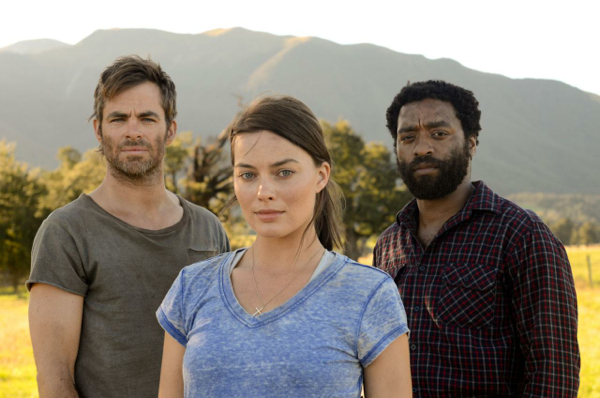Movie review by Greg Carlson
Craig Zobel’s film adaptation of “Z for Zachariah” is so loosely based on the book of the same name that fans of the novel will puzzle over many of the radical changes from page to screen. Written by Robert Leslie Conley under his pen name Robert C. O’Brien, “Z for Zachariah” was completed by the author’s wife and daughter following Conley’s death in 1973. Sometimes unfairly lumped in with other more recent young adult dystopian fiction that has made the jump to cinema, “Z for Zachariah” is quieter and more contemplative than “The Giver” (1993), “The Hunger Games” (2008), “The Maze Runner” (2009), and “Divergent” (2011). Zobel, working from a script by Nissar Modi, reimagines the Adam/Eve allegory as a love triangle, adding a third character absent in the book.
Margot Robbie is the ponderously named Ann Burden, a preacher’s daughter who appears to be the only human survivor of some unnamed catastrophe. Ann and her dog inhabit the family farm, doing the best they can to survive in a verdant valley somehow spared from the deadly radiation that has apparently settled over the rest of the world. One day, Ann encounters scientist John Loomis (Chiwetel Ejiofor), and both are surprised to discover another living person. Loomis and Ann bond partially over the delight and relief that comes from simple human companionship, and Zobel does an excellent job of heightening the sexual tension as the two grow closer.
Reviewers of the novel remarked on several themes that have been retained by the filmmaker, and chief among them is the sharp contrast between man of science Loomis, who engineers all kinds of improvements to the operation of the farm, and woman of faith Ann, whose religious beliefs stand in the way of destroying the church her father built (Loomis wants to use the wood to fashion a waterwheel). The introduction of Caleb (Chris Pine), effectively disintegrates the movie’s Edenic considerations, and as argued by Bilge Ebiri, “turns a moody, absorbing portrait of a compromised relationship into something more schematic and melodramatic.”
Zobel is so good with his actors, however, that some viewers may appreciate the application of the triangle trope. Zobel also offers icebox talk regarding unspoken dimensions of Ann’s position between the two men, including implications addressing both age and race. The impact of Caleb on Ann and Loomis is modulated by Zobel to include the possibility that the new visitor might be a dangerous encroacher whose motives are hidden. Caleb’s presence causes the viewer to ponder how we might act if we were in Ann’s situation. Zobel shifts his own explorations of gender into different territory than the original text – in the novel, Ann flees Loomis for a nearby cave.
Shot by Tim Orr in gorgeous outdoor locations in New Zealand on a modest budget, Zobel’s film adds another reason to watch the career of the talented moviemaker. Matthew Munn’s production design and Ken Turner’s art direction excel in describing a real sense of place. Robbie, Ejiofor, and Pine layer their characters with subtleties sometimes missing from the inevitable conflicts that attend the final actions of the story. Zobel, however, cagily holds back one key piece of visual information at the film’s climax, and the choice renders some ambiguity in a moment that might have otherwise been heavy-handed.
